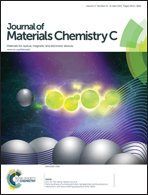Single-phase dual emissive Cu:CdS–ZnSe core–shell nanocrystals with “zero self-absorption” and their application in white light emitting diodes†
Abstract
Colloidal semiconductor nanocrystals (NCs) are among the most attractive phosphor materials to be exploited for solution-processed optoelectronic applications because of their unique properties. Hence, the development of single phase and low-cost luminescent NC phosphors with broad band emission is most desirable for use as color converters in white light-emitting diodes (WLEDs). In this paper, we demonstrate a single phase core–shell NC system consisting of Cu-doped CdS core–ZnSe shell NCs, which exhibits two emission bands under single-excitation wavelength, one of which was attributed to Cu-doped CdS and the other resulted from the CdS–ZnSe type-II core–shell structure. The dual emissive peaks were successfully tuned in the wavelength range from visible to near-infrared by simple control of the doped core size and the shell thickness, respectively. The as-prepared core–shell NCs not only exhibit characteristic “zero self-absorption,” but also show high quantum yield (56%) and good thermal stability after surface passivation by ZnS. The combination of a commercial blue LED chip with optimal core–shell NCs as color converters gave a high color rendering index of up to 90, Commission Internationale de l'Eclairage color coordinates of (0.325, 0.330), and a correlated color temperature of 5850 K. These results suggest that the as-prepared single phase NC phosphor has potential applications in WLEDs and correlated solid-state lighting.


 Please wait while we load your content...
Please wait while we load your content...